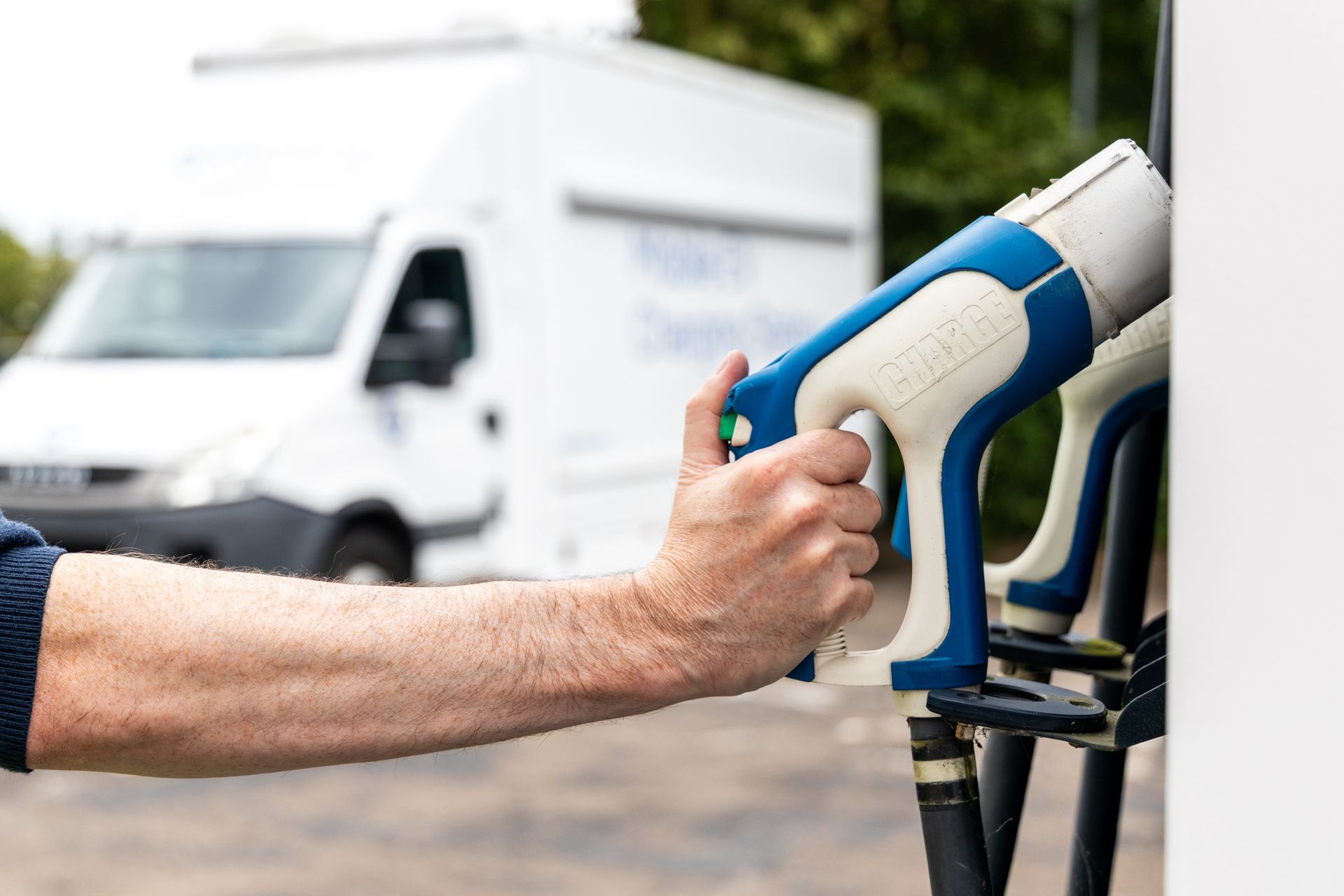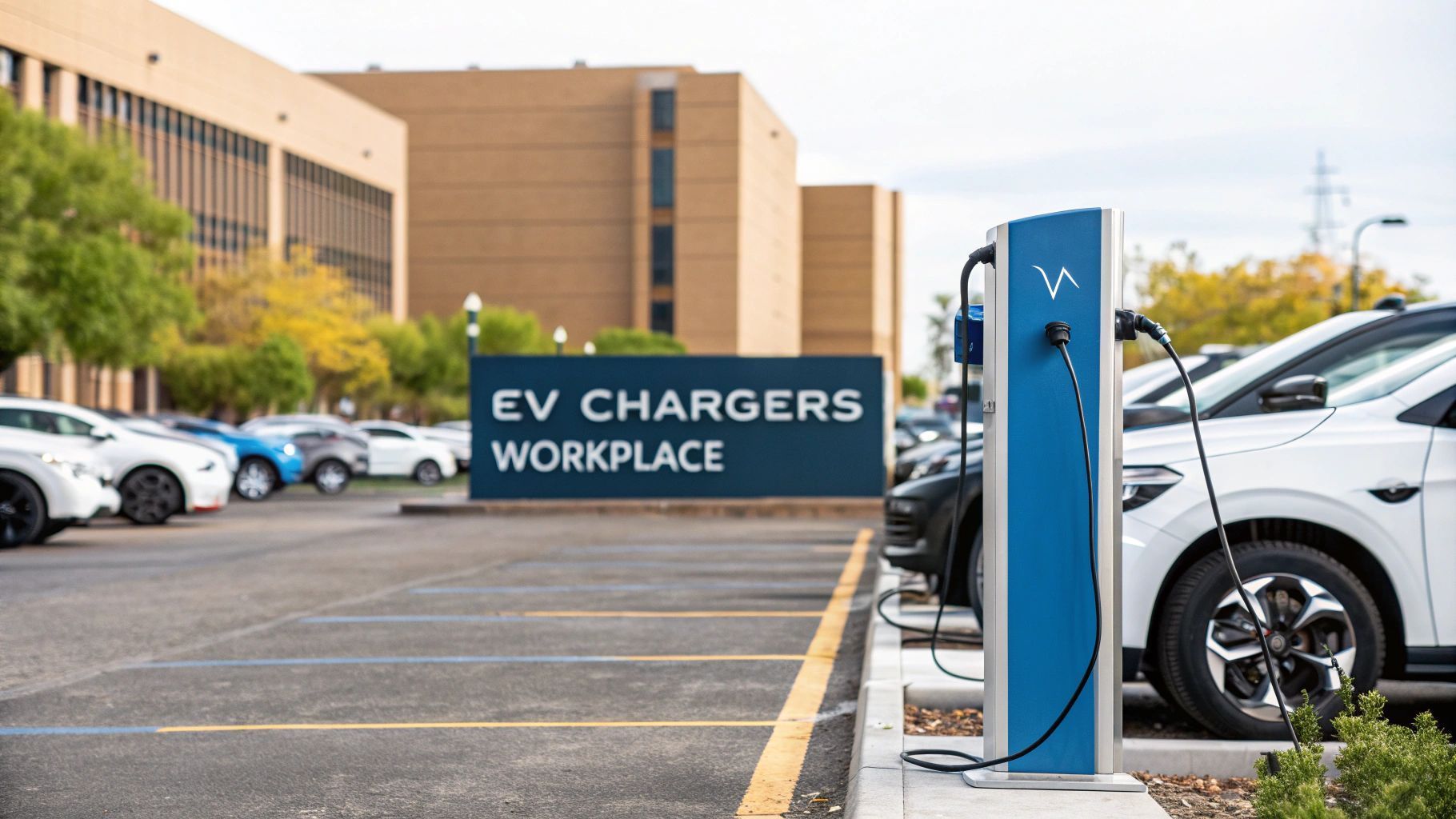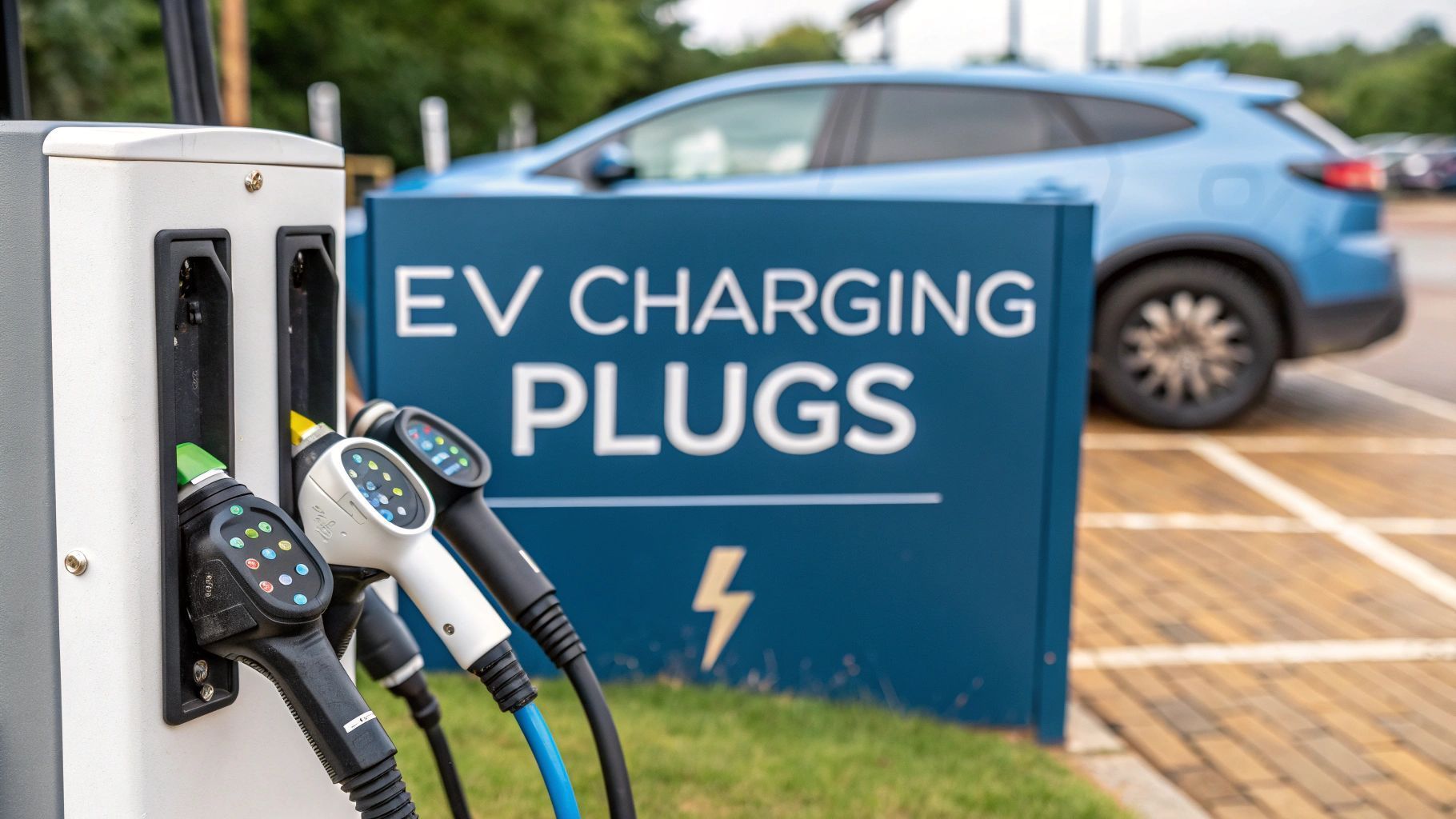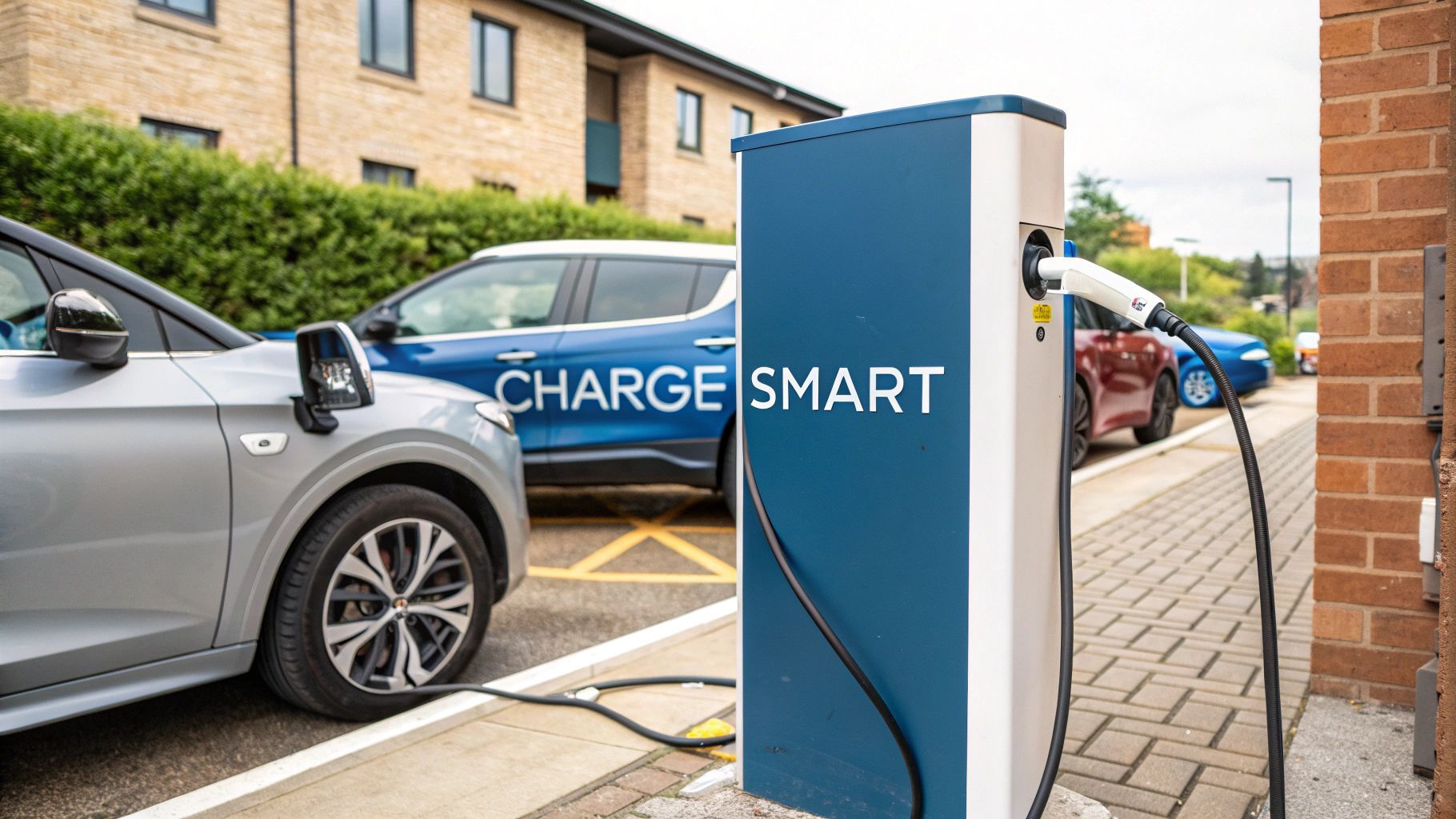UK Workplace EV Charging Guide
Workplace EV charging has quickly moved from being a nice-to-have employee perk to an absolute business necessity. For UK businesses, offering this isn't just a bonus but a strategic asset for attracting top talent, proving a real commitment to sustainability and future-proofing commercial properties for the inevitable EV takeover.
Why Workplace EV Charging Is A Strategic Business Move
The daily commute is changing and with it, the expectations of the modern workforce. As electric vehicles become a common sight on UK roads, the demand for easy, accessible charging has gone through the roof.
Businesses that get ahead of this shift aren't just ticking a box. They're making a powerful statement about their brand and their vision for the future. Providing workplace EV charging tells everyone you're forward-thinking, environmentally conscious and genuinely invested in your employees' lives.
This simple change turns the office car park from a patch of tarmac into a vital piece of infrastructure. It directly tackles 'range anxiety' for employees with longer journeys or those who can't charge at home, making their day-to-day lives easier and boosting job satisfaction. In today’s competitive job market, this seemingly small feature can be the very thing that makes a skilled professional choose you over a rival.
This infographic shows just how much workplace charging is now seen as a future-ready perk—essential for any modern business.
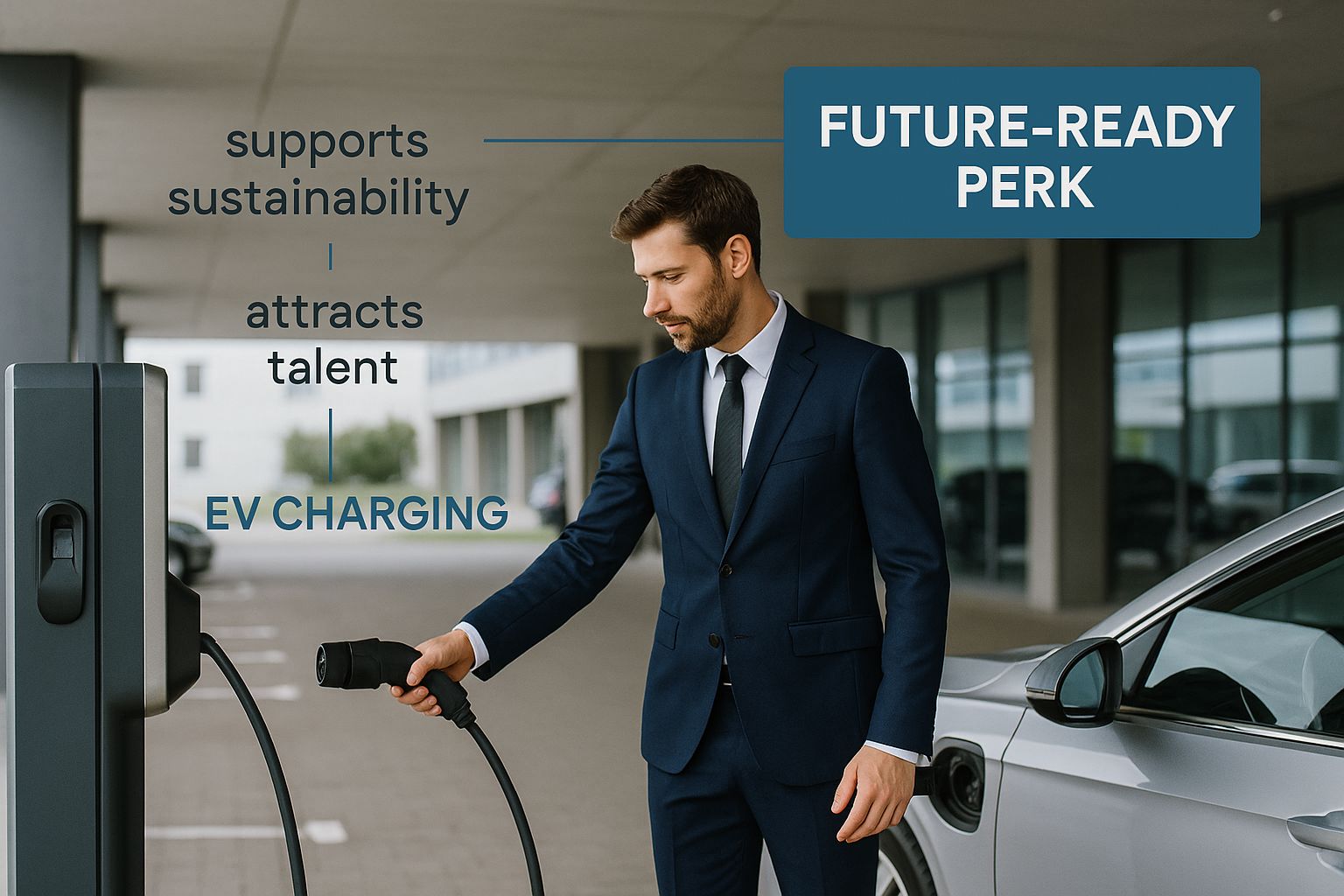
The image drives home the point: on-site charging is a cornerstone of a forward-thinking workplace strategy.
More Than Just a Perk: A New Revenue Opportunity
Beyond keeping staff happy, workplace charging can actually open up new financial doors. While fixed chargers are a great start, the real game-changer lies in flexible, on-demand solutions. Think about mobile EV charging, for instance—it can turn a cost centre into a profit centre. Imagine offering a premium charging service not just to your team but to neighbouring businesses as well.
By embracing innovative charging models, companies can generate a new revenue stream directly from their car park, turning an employee benefit into a tangible financial asset. This approach completely reframes the investment.
In this guide, we'll explore the different paths UK businesses can take. We’ll cover everything from traditional fixed chargers to the serious earning potential of running a mobile EV charging service. Our goal is to give you a clear roadmap so you can make an informed decision that benefits your employees, elevates your brand and strengthens your bottom line.
Investing in workplace EV charging is no longer a question of if but how.
Choosing Your Charging Infrastructure
Deciding on the right hardware for your workplace EV charging can feel like a puzzle but it really boils down to two main approaches: installing traditional fixed charging points or embracing the flexibility of a mobile charging service.
Think of it like this: fixed chargers are like installing landline telephones in every office. They’re reliable, permanently in place and serve a specific, designated spot. Mobile charging, on the other hand, is like providing company mobile phones—it’s an on-demand, flexible service that can be deployed wherever it’s needed most.
The best choice hinges entirely on your specific circumstances, including your site’s layout, budget, plans for scaling up and, crucially, your existing electrical capacity.
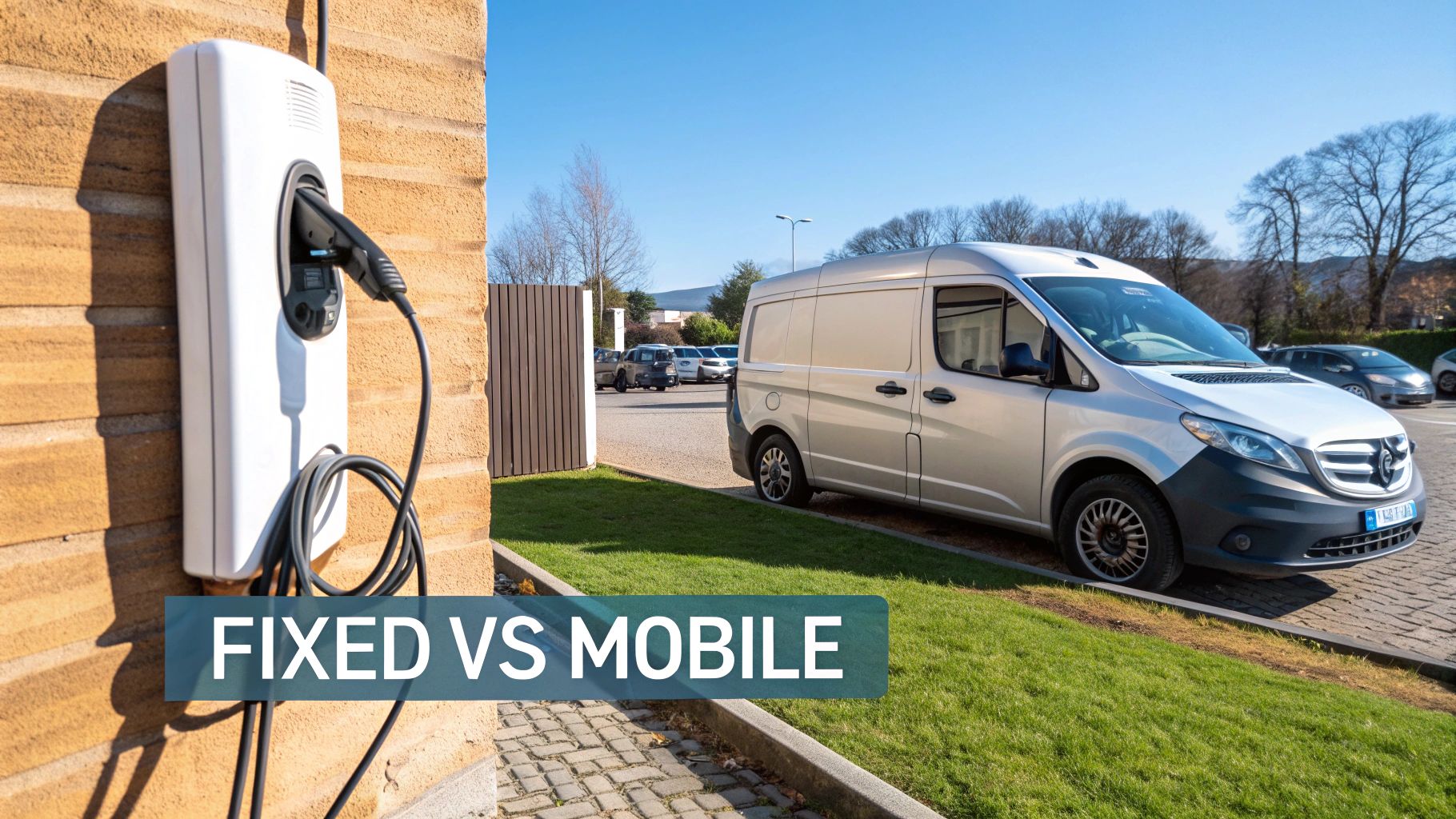
The Case for Mobile Charging Flexibility
While fixed chargers are the familiar option, mobile charging introduces a layer of agility and financial opportunity that’s hard to ignore. Instead of committing to permanent installations that demand significant upfront investment and potential groundwork, you can start with a single mobile unit.
This approach lets you test the waters and gauge employee demand without the commitment of a full-scale project. Before any installation, it’s vital to assess your site’s electrical capacity; a step like mastering electrical load calculation is critical. A mobile unit neatly bypasses many of these initial hurdles.
Mobile charging transforms the workplace car park from a static utility into a dynamic service hub. It provides charging exactly where and when it is needed, optimising space and resources without the need for extensive, permanent construction.
This is where its real power lies. You can move the charger to different areas, serve specific vehicles on a schedule or even cater to visitors and clients. It’s an adaptability that fixed infrastructure simply can’t offer. For a deeper look into this comparison, you can explore more about the future of stationary versus mobile EV charging solutions.
To help you weigh the options, here’s a straightforward comparison:
Fixed vs Mobile EV Charging for Your Workplace
| Feature | Fixed Charging Points | Mobile EV Charging |
|---|---|---|
| Installation | Requires civil works, grid connection and permanent space. | No installation needed; can be deployed immediately. |
| Upfront Cost | High initial investment in hardware and labour. | Lower entry cost; often available on a lease or service model. |
| Scalability | Adding new points is costly and disruptive. | Easily scalable by adding more mobile units as demand grows. |
| Flexibility | Static; tied to a specific parking bay. | Highly flexible; can be moved to any vehicle, anywhere on-site. |
| Revenue Model | Typically a cost centre or employee amenity. | Can be operated as a profit centre and new revenue stream. |
| Site Impact | Permanent changes to car park layout and electricals. | Minimal site impact; no permanent infrastructure required. |
Ultimately, while fixed chargers provide a predictable solution, mobile charging offers a dynamic, low-risk way to meet demand and even create new business opportunities.
Unlocking New Revenue Streams
Perhaps the most compelling argument for mobile charging is its potential to generate income. A fixed charger is often seen as a cost centre or an employee perk but a mobile charger can be operated as a profitable business venture. As an operator, you can create a tiered service model.
Consider these potential revenue opportunities:
- Premium Employee Service: Offer an on-demand charging service to staff for a fee, delivering convenience directly to their parking space.
- Inter-Business Services: Extend your service to neighbouring companies within your business park, creating a new B2B revenue stream.
- Public Charging: If your site allows, you could offer charging to the general public during off-peak hours or weekends.
The earning potential is significant. An operator charging a competitive rate of £0.55 per kWh with a 60kWh mobile unit could generate £33 per full charge . Completing just four charges a day could result in over £130 daily , translating to more than £34,000 annually from a single unit.
This simple shift in thinking transforms workplace EV charging from an operational expense into a substantial financial asset.
The Financial Case for Mobile EV Charging
While installing fixed charging points is a decent first step, mobile EV charging completely flips the financial script. It shifts the whole idea from a necessary cost or a simple employee perk into a powerful and surprisingly flexible profit centre. By going mobile, businesses can tap into brand-new revenue streams directly from their car park, turning what was once just an amenity into a serious financial asset.
Think about it: your car park becomes an active source of income. That's the real game-changer here. Instead of sinking thousands into permanent, fixed infrastructure, you're investing in a versatile service you can start earning from on day one. It’s a move that goes way beyond just covering your electricity bill; it’s about building a tangible, scalable business right on your doorstep.
This flexibility lets you build services that cater not just to your own team but to a much wider audience. The potential is huge, really only limited by your location and how you want to run things.
Building Your Mobile Charging Business Model
The beauty of a mobile charging service is just how adaptable it is. You're not stuck with a single purpose. Instead, you can design a multi-layered business model that keeps your mobile unit busy and earning money, which is a world away from a fixed charger that serves one bay at a time and often sits idle.
A mobile charger, on the other hand, is an asset you can actively send out to meet demand wherever it pops up. This proactive approach to workplace EV charging opens the door to several distinct ways to make money.
Here are a few concrete business models you could roll out:
- Premium On-Demand Employee Service: Offer a concierge-style charging service where staff can book a charge right at their parking space. That level of convenience easily justifies a premium price per kWh over what they’d pay at a public charger.
- Business Park Service Hub: If you’re based on a shared commercial estate, why not extend your mobile charging service to the businesses next door? You could set up contracts or offer a simple pay-as-you-go service, quickly becoming the go-to energy provider for the whole park.
- Visitor and Client Charging: Turn visitor parking into a revenue stream by offering an easy, efficient charging solution for clients, suppliers or any other guests visiting your site.
- Fleet Charging Solutions: Set up scheduled charging for your own company fleet or offer the service to other local businesses running electric vans or cars.
This kind of strategic thinking ensures your mobile charging unit is consistently generating revenue, dramatically speeding up your return on investment.
Calculating Your Potential Revenue
To get a real sense of the financial impact, let's run through a quick, hypothetical revenue calculation. The numbers show pretty clearly how a mobile charger can become a profitable part of your business. The key factors are simple: the price you set per kilowatt-hour (kWh), the capacity of your mobile unit and how many charges you handle each day.
Let’s assume the following:
- Mobile Charger Capacity: A standard 60kWh unit.
- Price Per kWh: A competitive rate of £0.55 per kWh .
- Charges Per Day: A conservative target of just four full charges during a workday.
With these figures, the potential earnings start to look very attractive. A single full 60kWh charge would bring in £33 in revenue (£0.55 x 60).
Completing just four of these charges per day translates to £132 in daily revenue . Over a standard working year (around 260 days), this single mobile unit could generate over £34,000 in annual turnover .
This simple calculation highlights the serious income potential from just one unit on a modest schedule. Scaling up by adding more units or extending your service hours would grow this figure exponentially. For any business looking to diversify, this is a low-overhead, high-demand opportunity. To dig deeper into the numbers, check out this detailed breakdown of the economics of mobile EV charging and its business models.
Analysing Profit Margins and ROI
Of course, turnover is one thing but profit is what really counts. The good news is that the operating costs for a mobile EV charger are remarkably low compared to the revenue it can pull in. Your main expense is the electricity used to charge the mobile unit itself, which you can easily do overnight using cheaper off-peak tariffs.
Let's break down the potential profit margin:
- Revenue per charge (60kWh): £33.00
- Off-peak electricity cost (at £0.15/kWh): £9.00
- Gross profit per charge: £24.00
That works out to a gross profit margin of over 70% —a figure that’s hard to come by in most other business ventures. You might have other minor costs like maintenance or software but the fundamental profitability is exceptionally strong.
This high margin leads to a very fast return on investment (ROI). Unlike fixed infrastructure, which can take years to pay for itself (if it ever does), a mobile charging operation can break even in a much shorter timeframe. A business that actively markets its service to employees and neighbouring companies could see a full return on its initial investment in as little as 12-18 months. After that, the unit is a pure profit-generating machine. This quick ROI makes mobile workplace EV charging an incredibly compelling financial move for any forward-thinking UK business.
Tapping into UK Government Grants and Funding
Putting EV charging infrastructure into your workplace is a smart, future-focused move but let’s be honest—the upfront cost can look pretty daunting. The good news is that the UK government has put some serious financial incentives in place to soften the blow and make the transition much easier for businesses.
These grants can slash the initial capital you need, turning a major project into a far more manageable investment. By taking advantage of these schemes, you can fast-track your plans to offer a modern, essential amenity for your staff and fleet. The main programme you need to know about is the Workplace Charging Scheme (WCS), a straightforward voucher system that cuts the cost of installing new charge points right at the source.
Getting to Grips with the Workplace Charging Scheme
The key government incentive for businesses is the Workplace Charging Scheme (WCS) . Think of it as a direct discount on the price of buying and fitting new EV charge points. If your business is eligible, the grant will cover up to 75% of the total costs , with a cap of £350 per socket .
You can claim this funding for a total of 40 sockets across all your sites, meaning a single business could get up to £14,000 in support. It’s a significant helping hand designed to get more chargers into the ground.
And it's working. As of July 2025, the WCS has already funded the installation of a massive 63,777 sockets in workplace car parks since it launched in 2016. In the year ending 1 July 2025 alone, the scheme backed 7,924 sockets , showing just how many businesses are getting on board. You can dive into the numbers yourself by reading the full government report on EV charging grant schemes.
Of course, to get your hands on this funding, your business needs to tick a few boxes first.
Understanding the Eligibility Criteria
The government has put clear rules in place to make sure the funding goes where it’s intended. Not every organisation can simply apply.
To be eligible for the WCS, your organisation must:
- Be a registered business, charity or public sector body.
- Have dedicated off-street parking for your staff or fleet.
- Either own the property or have permission from the landlord to install the chargers.
- Use an OZEV-approved installer for the entire job.
Crucially, this scheme is not for your employees' home addresses. It is specifically for commercial premises, reinforcing its purpose: to build out a solid network of workplace EV charging stations across the country.
The application itself is surprisingly simple. You start with an online form to check you're eligible. If you get the green light, you’re issued a unique voucher code. All you have to do is give this code to your approved installer.
They handle the rest, claiming the grant on your behalf and taking the amount straight off your final bill. This voucher system means you get the discount immediately, without having to pay the full amount and then reclaim it. It makes managing the project's finances much cleaner and more predictable.
Selecting the Right UK Charging Partner
Choosing the right hardware is a great start but your long-term success with workplace EV charging really hinges on the partner you choose to manage it all. Think of it this way: the physical charger is just one piece of the puzzle. The network provider and their management platform are what will ultimately make or break the experience for both you and your employees.
A great partner does so much more than just sell you a box. They provide a seamless, reliable service that handles everything from driver payments to performance monitoring, taking the headache out of the day-to-day operations. When you're looking at potential UK-based partners, you have to look beyond the initial price tag and scrutinise the entire package they offer.
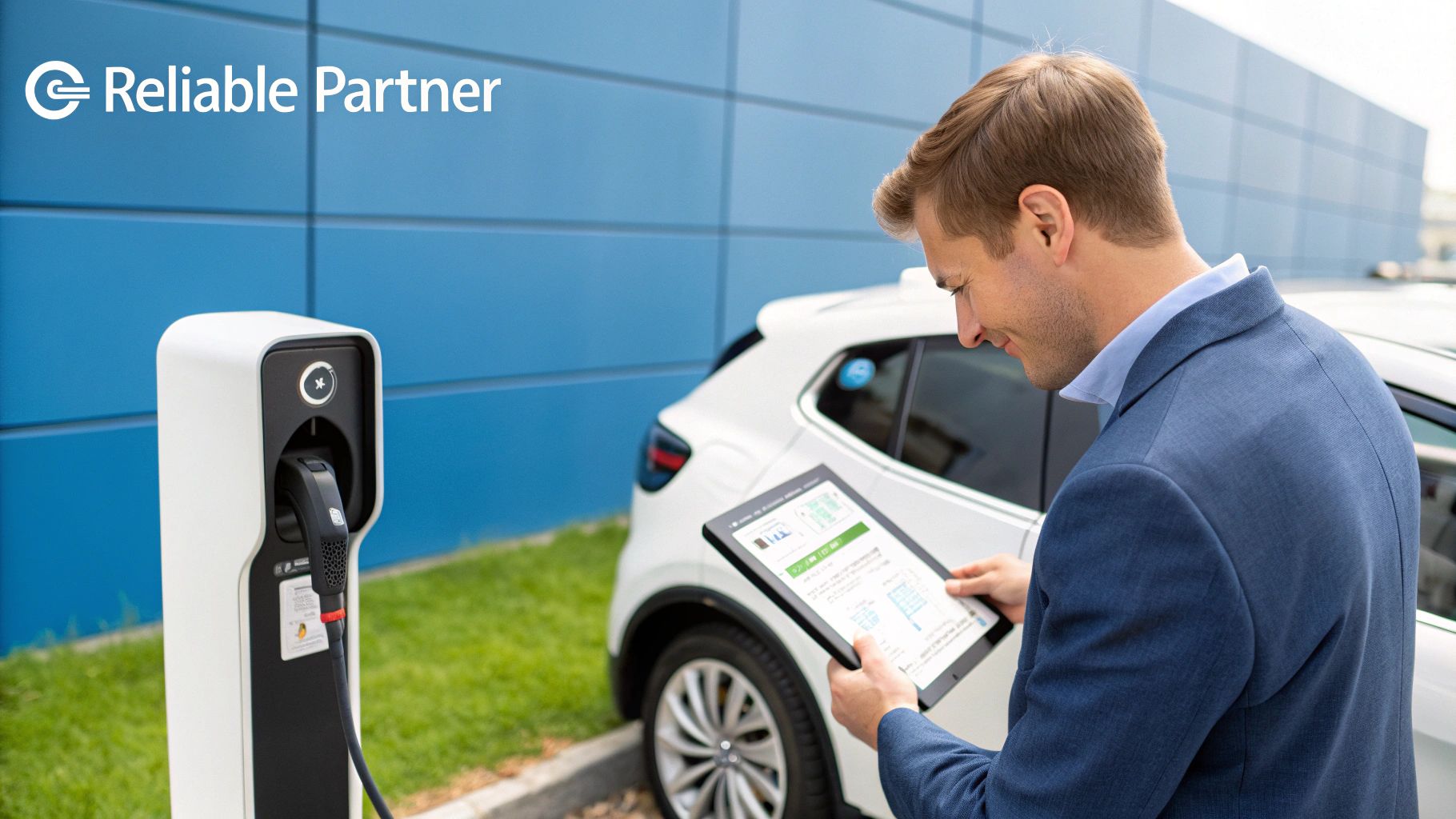
Core Features to Evaluate in a Provider
The UK market for EV charging networks is competitive and growing fast. Recent research shows that some providers have a significant head start. For instance, as of January 2024, POD Point had installed over three times the number of workplace charging stations as its nearest competitor, ChargePlace Scotland. This really highlights a dynamic market where established names and new players are all vying to provide the best service. You can dig deeper into the leading UK workplace charging networks with recent Statista findings on the topic.
When you’re weighing up your options, focus on these essential factors:
- Hardware Reliability: Does the provider offer robust, durable chargers that can withstand daily use in a commercial setting? Look for partners with a proven track record and solid warranties.
- Management Software: The software is your command centre. It should be intuitive, allowing you to set pricing, monitor usage and manage access without needing an IT degree.
- Customer Support: When a charger goes down—and it will—you need a responsive support team on the other end of the phone. Check their service level agreements (SLAs) and read reviews about their actual support quality.
- Transparent Pricing: Your partner’s pricing model should be crystal clear. Steer clear of providers with complex fee structures or hidden costs that can quietly eat into your returns.
The Importance of Smart Charging Capabilities
A modern charging partner has to offer more than just a power supply. Their system needs to include smart features that optimise how you use energy and improve the driver experience. These capabilities are vital for running an efficient and cost-effective workplace EV charging programme.
A truly effective charging partner provides the intelligence behind the hardware. Smart features like load balancing and detailed analytics transform a simple utility into a managed asset that can adapt to your building's energy demands and provide clear operational insights.
Load balancing is a particularly big deal. This feature intelligently distributes the available power across multiple chargers, preventing your building’s electrical system from getting overloaded during peak times. It means you can install more chargers without needing eye-wateringly expensive grid upgrades, saving a huge amount of money right from the start.
Seamless payment processing is another must-have. Employees and visitors should be able to pay easily via a simple app or a contactless card. The system should also give you detailed usage analytics, offering up valuable data on charging patterns, energy consumption and revenue generation. This is the information you'll need to make informed decisions and scale your operation effectively down the line. By prioritising these features, you can be sure you're picking a partner that not only meets today’s needs but is also ready to support your future growth.
Putting Your Workplace Charging Strategy into Action
A successful workplace EV charging programme doesn't happen by accident. It's the result of careful, deliberate planning. Moving from the initial idea to a fully operational service requires a clear, step-by-step roadmap to avoid the common pitfalls and make sure the launch goes smoothly for your employees.
This process starts long before you even think about ordering hardware. The first, and most critical, stage is to get a real sense of the demand within your organisation. From there, you can tackle the technical and logistical challenges of the installation itself.
To get this right, you need a clear strategy. Using a comprehensive guide to business and strategic planning can give you a solid framework to build and execute your workplace charging plan.
Figure Out Employee Demand and Site Suitability
Before you spend a penny, you need data. Start by gauging employee demand with simple, anonymous surveys. Ask your team about their current EV ownership, if they're planning to buy one soon and whether they have reliable charging at home. This will give you a baseline to understand the immediate need.
At the same time, a professional site evaluation is non-negotiable. This assessment will figure out your building's electrical capacity and pinpoint the best spots for charging points. It’s a vital step that prevents expensive surprises down the line, like discovering your grid connection needs a major—and costly—upgrade.
Develop Clear Usage Policies
Once you've confirmed the need and technical feasibility, it's time to establish the rules of engagement. A well-defined usage policy prevents confusion and makes sure everyone gets fair access.
Your policy should cover key areas like:
- Pricing Structure: Will charging be free, subsidised or priced to turn a profit? State the cost per kWh clearly.
- Time Limits: To stop people from hogging a charging bay all day, set reasonable time limits, such as a four-hour maximum.
- Access Control: Who gets to use the chargers? Is it for employees only or can visitors and clients plug in as well?
- Booking System: Will you use an app for booking slots or will it be a first-come, first-served system?
Setting these expectations from the get-go is critical for managing the facility effectively. A clear policy, communicated well, ensures the system is used fairly and efficiently, preventing disputes before they even start.
Communicate and Manage the Rollout
With your policies locked in, the final steps are all about communication and ongoing management. Announce the new benefit to your team, explaining how the system works, any associated costs and the general etiquette for using the chargers. A strong communication plan builds excitement and encourages people to actually use them.
Finally, set up a plan for ongoing management and maintenance to ensure the chargers remain reliable for the long haul. Regular checks and responsive support are essential for keeping them operational and delivering a dependable service. This proactive approach ensures your investment continues to provide value for years to come. For a more detailed walkthrough, our complete UK commercial EV charging installation guide offers an even deeper dive into the process.
Still Have Questions About Workplace EV Charging?
Even with a clear plan, many UK businesses find themselves puzzling over the practicalities of setting up EV charging on-site. Let's walk through some of the most common questions to give you the final pieces of the puzzle.
How Much Does It Really Cost to Install EV Chargers at a UK Workplace?
There's no single price tag, as installation costs can swing wildly depending on the charger type, how many you need and how complex your site is. A standard 7kW wall-mounted charger might set you back between £800 and £1,500 per unit once installed. But if you’re looking at powerful DC rapid chargers, the cost can easily jump into the tens of thousands.
The good news is you don't have to foot the entire bill yourself. The Workplace Charging Scheme (WCS) grant is a crucial tool for managing this expense, offering up to £350 per socket for as many as 40 sockets . To get a figure you can actually budget with, a professional site survey is always the essential first step.
Can My Business Actually Earn Money from Workplace EV Charging?
Absolutely. While some companies are happy to offer free charging as a staff perk, many others set a price per kWh. This doesn't just cover the electricity and maintenance costs—it can also generate a modest profit.
But the real revenue opportunity? That lies in mobile EV charging. By operating a mobile unit, you can offer a premium, on-demand service to both your employees and other businesses nearby. This approach transforms a simple staff amenity into a genuinely substantial new income stream.
What Are the Main Benefits of Offering EV Charging to Staff?
The advantages of providing workplace EV charging are significant, touching multiple parts of your business. The biggest wins include:
- Attracting and Retaining Talent: In a competitive job market, EV charging is a highly sought-after benefit that can make you stand out.
- Boosting Your Green Credentials: It’s tangible proof of your company's commitment to corporate social responsibility (CSR) and a smaller carbon footprint.
- Future-Proofing Your Premises: You're getting your property ready for the inevitable all-electric vehicle future, putting you ahead of the curve.
- Improving Staff Morale: It’s a simple convenience that reduces 'range anxiety' and makes daily life much easier for your EV-driving employees.
Ready to turn your car park into a profit centre? Discover how ZAPME 's mobile charging solutions can create new revenue streams and future-proof your business. Explore our flexible options.

